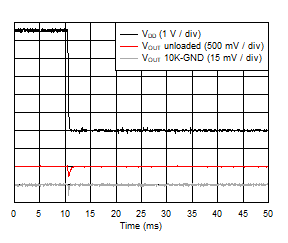at TA = 25°C, 10-bit DAC, and DAC outputs unloaded (unless otherwise noted)
 Figure 7-22 Integral Linearity Error vs Supply Voltage
Figure 7-22 Integral Linearity Error vs Supply Voltage Figure 7-24 Total
Unadjusted Error vs Supply Voltage
Figure 7-24 Total
Unadjusted Error vs Supply Voltage Figure 7-26 Offset Error vs Supply Voltage
Figure 7-26 Offset Error vs Supply Voltage Figure 7-28 Full-Scale Error vs Supply Voltage
Figure 7-28 Full-Scale Error vs Supply Voltage Figure 7-30 Supply Current vs Digital Input Code
Figure 7-30 Supply Current vs Digital Input Code
| Internal reference (gain = 4x), DAC at midscale |
Figure 7-32 Supply Current vs Temperature
| Reference = VDD, DAC powered down |

| Reference = VDD = 5.5 V, DAC code transition
from midscale to midscale + 1 LSB, DAC load = 5kΩ ||
200pF |
Figure 7-36 Glitch Impulse, Rising Edge, 1-LSB Step
| Reference = VDD = 5.5 V, DAC load = 5kΩ ||
200pF |
Figure 7-38 Full-Scale Settling Time, Rising Edge Figure 7-40 Power-on Glitch
Figure 7-40 Power-on Glitch
| Reference = VDD = 5.5 V, Fast+ mode, DAC at
midscale, DAC load = 5kΩ || 200pF |
Figure 7-42 Clock
Feedthrough Figure 7-44 DAC
Output Noise Spectral Density
Figure 7-44 DAC
Output Noise Spectral Density
| Reference = VDD = 5.5 V, DAC at
midscale |
Figure 7-46 DAC
Output Noise: 0.1 Hz to 10 Hz Figure 7-23 Differential Linearity Error vs Supply Voltage
Figure 7-23 Differential Linearity Error vs Supply Voltage Figure 7-25 Zero-Code Error vs Supply Voltage
Figure 7-25 Zero-Code Error vs Supply Voltage Figure 7-27 Gain
Error vs Supply Voltage
Figure 7-27 Gain
Error vs Supply Voltage Figure 7-29 Supply Current vs Digital Input Code
Figure 7-29 Supply Current vs Digital Input Code
| Reference = VDD, DAC at midscale |
Figure 7-31 Supply Current vs Temperature Figure 7-33 Supply Current vs Supply Voltage
Figure 7-33 Supply Current vs Supply Voltage Figure 7-35 Source and Sink Capability
Figure 7-35 Source and Sink Capability
| Reference = VDD = 5.5 V, DAC code transition
from midscale to midscale – 1 LSB, DAC load = 5kΩ ||
200pF |
Figure 7-37 Glitch Impulse, Falling Edge, 1-LSB Step
| Reference = VDD = 5.5 V, DAC load = 5kΩ ||
200pF |
Figure 7-39 Full-Scale Settling Time, Falling Edge Figure 7-41 Power-off Glitch
Figure 7-41 Power-off Glitch
| Internal reference (gain = 4x), VDD = 5.25 V + 0.25 VPP, DAC at midscale, DAC load = 5kΩ || 200pF |

| Internal reference (gain = 4x), VDD = 5.5
V |
Figure 7-45 DAC
Output Noise Spectral Density
| Internal reference (gain = 4x), VDD = 5.5 V,
DAC at midscale |
Figure 7-47 DAC
Output Noise: 0.1 Hz to 10 Hz
























